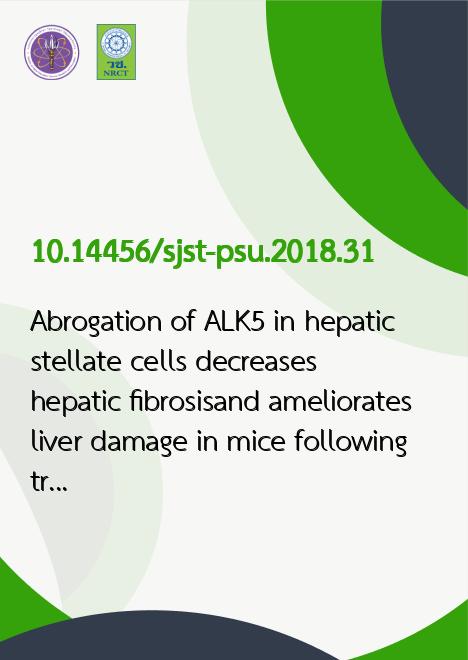
|
Abrogation of ALK5 in hepatic stellate cells decreases hepatic fibrosisand ameliorates liver damage in mice following treatmentwith thioacetamide |
|---|---|
| รหัสดีโอไอ | |
| Creator | 1. Somyoth Sridurongrit 2. Chen Ke 3. Wanthita Kongphat 4. Arnon Pudgerd 5. Chanyatip Suwannasing |
| Title | Abrogation of ALK5 in hepatic stellate cells decreases hepatic fibrosisand ameliorates liver damage in mice following treatmentwith thioacetamide |
| Publisher | Research and Development Office, Prince of Songkla University |
| Publication Year | 2561 |
| Journal Title | Songklanakarin Journal of Science and Technology |
| Journal Vol. | 40 |
| Journal No. | 2 |
| Page no. | 314 |
| Keyword | TGF-?, ALK5, hepatic stellate cells, fibrosis, liver injury |
| URL Website | http://rdo.psu.ac.th/sjstweb/index.php |
| ISSN | 0125-3395 |
| Abstract | While transforming growth factor-? (TGF-?) is known to be a key inducer of hepatic stellate cell (HSC) activationduring liver fibrosis but it is unclear which TGF-? receptor is required for this HSC-mediated fibrogenesis. Here, we report thatabrogation of TGF-? type I receptor ALK5 in HSC activation led to reduced collagen deposition and a decreased number ofmyofibroblasts in livers of mutant mice lacking ALK5 in HSC (Alk5/GFAP-Cre mice) following thioacetamide (TAA) exposure.The reduced fibrosis was accompanied by decreased expression of HSC activation markers in livers. In addition, Alk5/GFAP-Cremice exhibited decreased immune cell infiltration and reduced production of inflammatory cytokines. Associated with reducedfibrosis and inflammation, amelioration of liver injury was observed in Alk5/GFAP-Cre mice after TAA treatment. In conclusion,our results indicated that TGF-? signaling via ALK5 in HSC enhanced liver fibrogenesis and inflammation led to amplificationof hepatic injury in mice exposed to TAA. |
